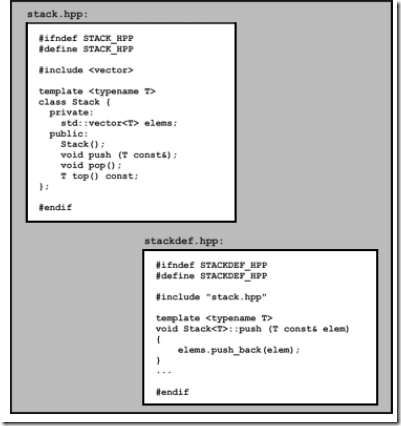一.包含模型
一份头文件hpp,一份cpp实现文件
hpp:
#ifndef MYFIRST_HPP
#define MYFIRST_HPP
// declaration of template
template <typename T>
void print_typeof (T const&);
#endif // MYFIRST_HPP
cpp:
#include <iostream>
#include <typeinfo>
#include "myfirst.hpp"
// implementation/definition of template
template <typename T>
void print_typeof (T const& x)
{
std::cout << typeid(x).name() << std::endl;
}
使用模板函数:
#include "myfirst.hpp"
// use of the template
int main()
{
double ice = 3.0;
print_typeof(ice); // call function template for type double
}
将会导致链接错误,必须有一个基于double实例化的函数定义
为了通过编译,有2两种办法:
1.把cpp文件包含在头文件里面
2.在使用模板的文件中引用cpp文件
3.不要cpp文件,将声明和实现都放在hpp文件里面
#define MYFIRST_HPP
#include <iostream>
#include <typeinfo>
// declaration of template
template <typename T>
void print_typeof (T const&);
// implementation/definition of template
template <typename T>
void print_typeof (T const& x)
{
std::cout << typeid(x).name() << std::endl;
}
#endif // MYFIRST_HPP
开销:
1.增加了头文件的大小
2.增加了编译复杂度
二.手工显式实例化
声明一个显式实例化的头文件
#include "myfirst.hpp"
// explicitly instantiate print_typeof() for type double
template void print_typeof<double>(double const&);
现在使用这个头文件,编译正常
#include "myfirstinst.cpp"
// use of the template
int main()
{
double ice = 3.0;
print_typeof(ice); // call function template for type double
}
优点:避免了庞大的头文件开销
注意点:一个程序中最多只有一个显式实例化体
三.整合包含模型和显式实例化
如上声明3份文件.
- 1份头文件
- 1份实现文件
- 一份显式实例化文件
如下2种用法:
第一种使用应该引用“stackdef.hpp”

